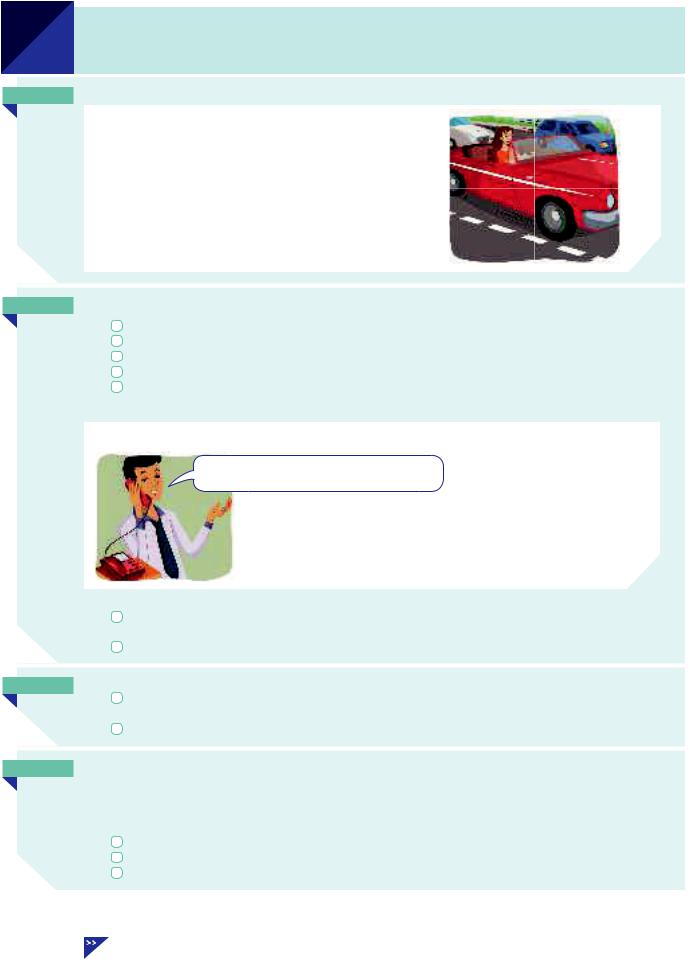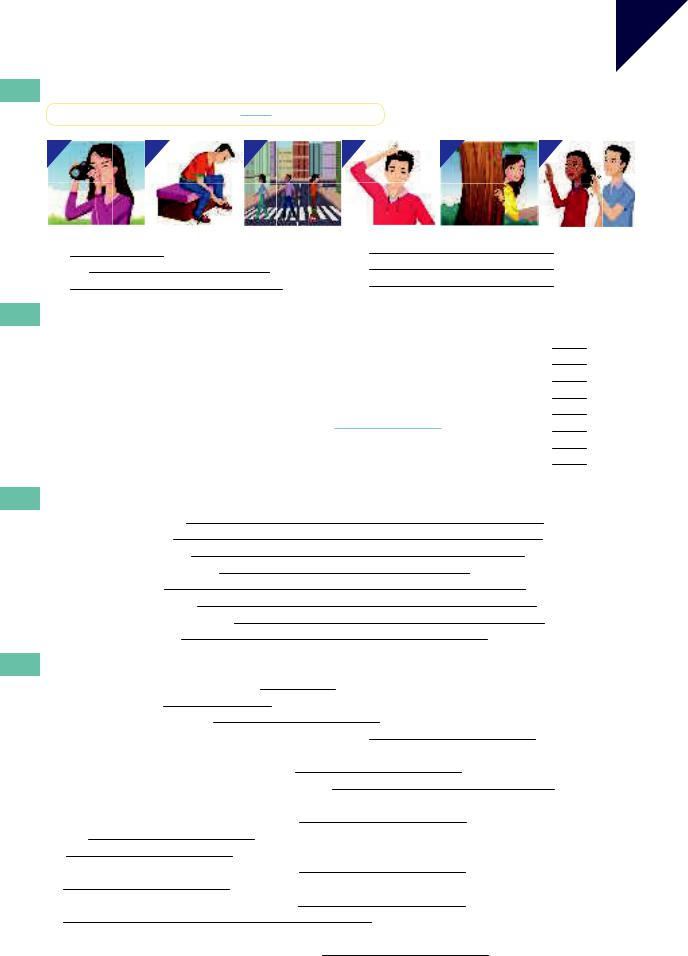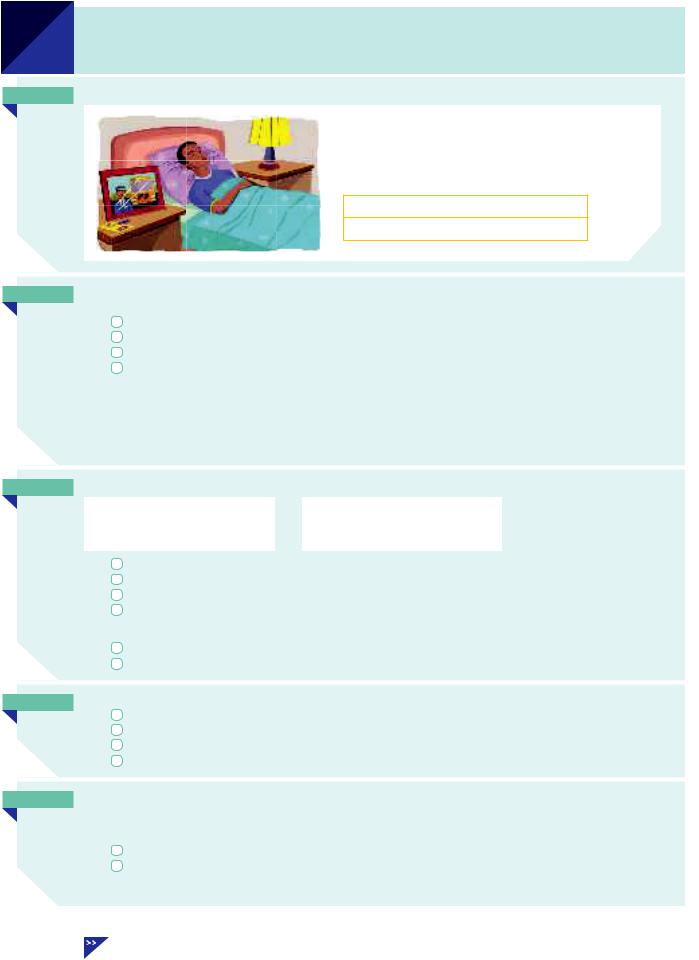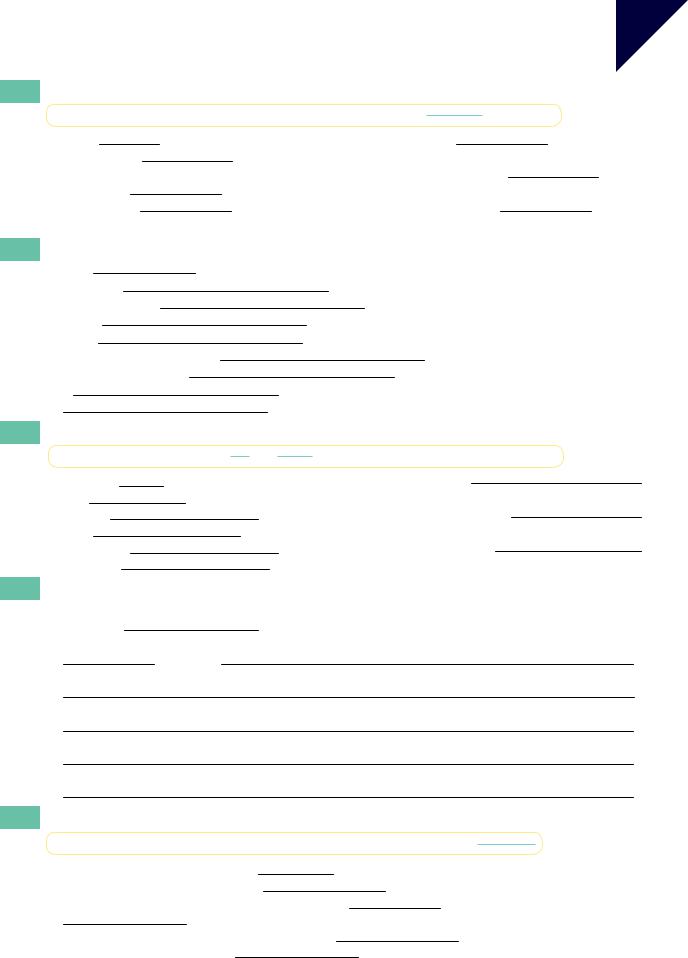
- •Contents
- •Thanks
- •To the student
- •To the teacher
- •3 Present continuous and present simple 1 (I am doing and I do)
- •10 Present perfect continuous and simple (I have been doing and I have done)
- •11 how long have you (been) … ?
- •12 for and since when … ? and how long … ?
- •13 Present perfect and past 1 (I have done and I did)
- •14 Present perfect and past 2 (I have done and I did)
- •15 Past perfect (I had done)
- •16 Past perfect continuous (I had been doing)
- •17 have and have got
- •18 used to (do)
- •19 Present tenses (I am doing / I do) for the future
- •20 I’m going to (do)
- •21 will and shall 1
- •22 will and shall 2
- •23 I will and I’m going to
- •24 will be doing and will have done
- •26 can, could and (be) able to
- •27 could (do) and could have (done)
- •28 must and can’t
- •29 may and might 1
- •30 may and might 2
- •31 have to and must
- •32 must mustn’t needn’t
- •33 should 1
- •34 should 2
- •35 I’d better … it’s time …
- •36 would
- •39 if I knew … I wish I knew …
- •40 if I had known … I wish I had known …
- •41 wish
- •42 Passive 1 (is done / was done)
- •43 Passive 2 (be done / been done / being done)
- •44 Passive 3
- •45 it is said that … he is said to … he is supposed to …
- •46 have something done
- •47 Reported speech 1 (he said that …)
- •48 Reported speech 2
- •49 Questions 1
- •52 Question tags (do you? isn’t it? etc.)
- •53 Verb + -ing (enjoy doing / stop doing etc.)
- •54 Verb + to … (decide to … / forget to … etc.)
- •55 Verb (+ object) + to … (I want you to …)
- •56 Verb + -ing or to … 1 (remember, regret etc.)
- •57 Verb + -ing or to … 2 (try, need, help)
- •58 Verb + -ing or to … 3 (like / would like etc.)
- •59 prefer and would rather
- •60 Preposition (in/for/about etc.) + -ing
- •61 be/get used to … (I’m used to …)
- •63 there’s no point in -ing, it’s worth -ing etc.
- •64 to … , for … and so that …
- •65 Adjective + to …
- •66 to … (afraid to do) and preposition + -ing (afraid of -ing)
- •67 see somebody do and see somebody doing
- •68 -ing clauses (He hurt his knee playing football.)
- •69 Countable and uncountable 1
- •70 Countable and uncountable 2
- •71 Countable nouns with a/an and some
- •74 the 2 (school / the school etc.)
- •75 the 3 (children / the children)
- •77 Names with and without the 1
- •78 Names with and without the 2
- •79 Singular and plural
- •80 Noun + noun (a bus driver / a headache)
- •81 -’s (your sister’s name) and of … (the name of the book)
- •82 myself/yourself/themselves etc.
- •83 a friend of mine my own house on my own / by myself
- •84 there … and it …
- •85 some and any
- •87 much, many, little, few, a lot, plenty
- •90 all every whole
- •91 each and every
- •92 Relative clauses 1: clauses with who/that/which
- •94 Relative clauses 3: whose/whom/where
- •95 Relative clauses 4: extra information clauses (1)
- •96 Relative clauses 5: extra information clauses (2)
- •97 -ing and -ed clauses (the woman talking to Tom, the boy injured in the accident)
- •98 Adjectives ending in -ing and -ed (boring/bored etc.)
- •99 Adjectives: a nice new house, you look tired
- •100 Adjectives and adverbs 1 (quick/quickly)
- •102 so and such
- •104 quite, pretty, rather and fairly
- •105 Comparative 1 (cheaper, more expensive etc.)
- •106 Comparative 2 (much better / any better etc.)
- •107 Comparative 3 (as … as / than)
- •108 Superlative (the longest / the most enjoyable etc.)
- •109 Word order 1: verb + object; place and time
- •110 Word order 2: adverbs with the verb
- •111 still any more yet already
- •112 even
- •114 in case
- •116 as (as I walked … / as I was … etc.)
- •117 like and as
- •119 during for while
- •121 at/on/in (time)
- •122 on time and in time at the end and in the end
- •123 in/at/on (position) 1
- •124 in/at/on (position) 2
- •125 in/at/on (position) 3
- •126 to, at, in and into
- •127 in/on/at (other uses)
- •129 Noun + preposition (reason for, cause of etc.)
- •130 Adjective + preposition 1
- •131 Adjective + preposition 2
- •132 Verb + preposition 1 to and at
- •134 Verb + preposition 3 about and of
- •135 Verb + preposition 4 of/for/from/on
- •136 Verb + preposition 5 in/into/with/to/on
- •137 Phrasal verbs 1 Introduction
- •138 Phrasal verbs 2 in/out
- •139 Phrasal verbs 3 out
- •142 Phrasal verbs 6 up/down
- •143 Phrasal verbs 7 up (1)
- •144 Phrasal verbs 8 up (2)
- •145 Phrasal verbs 9 away/back
- •Additional exercises
- •Study guide
- •Key to Exercises
- •Key to Additional exercises (see page 302)
- •Key to Study guide
- •Index

Thanks
This is the fith edition of English Grammar in Use. I wrote the original edition when I was a teacher at the Swan School of English, Oxford. I would like to repeat my thanks to my former colleagues and students at the school for their help, encouragement and interest at that time.
Regarding the production of this fith edition, I would like to thank Rebecca Winthrop and Chris Capper.
Design & Illustrations
Q2A Media Services Pvt. Ltd.
vii

To the student
This book is for students who want help with English grammar. It is written for you to use without a teacher.
The book will be useful for you if you are not sure of the answers to questions like these:
What is the diference between I did and I have done?
When do we use will for the future?
What is the structure ater I wish?
When do we say used to do and when do we say used to doing?
When do we use the?
What is the diference between like and as?
These and many other points of English grammar are explained in the book, and there are exercises on each point.
Level
The book is intended mainly for intermediate students (students who have already studied the basic grammar of English). It concentrates on those structures that intermediate students want to use, but that oten cause dificulty. Some advanced students who have problems with grammar will also find the book useful.
The book is not suitable for elementary learners.
How the book is organised
There are 145 units in the book. Each unit concentrates on a particular point of grammar. Some problems (for example, the present perfect or the use of the) are covered in more than one unit. For a list of units, see the Contents at the beginning of the book.
Each unit consists of two facing pages. On the let there are explanations and examples; on the right there are exercises. At the back of the book there is an Answer Key for you to check your answers to the exercises (page 336).
There are also seven Appendices at the back of the book (pages 292–301). These include irregular verbs, summaries of verb forms, spelling, and American English.
Finally, there is a detailed Index at the back of the book (page 373).
How to use the book
The units are not in order of dificulty, so it is not intended that you work through the book from beginning to end. Every learner has diferent problems, and you should use this book to help you with the grammar that you find dificult.
It is suggested that you work in this way:
Use the Contents and/or Index to find which unit deals with the point you are interested in. If you are not sure which units you need to study, use the Study guide on page 326.
Study the explanations and examples on the let-hand page of the unit you have chosen. Do the exercises on the right-hand page.
Check your answers with the Key.
If your answers are not correct, study the let-hand page again to see what went wrong.
You can, of course, use the book simply as a reference book without doing the exercises.
viii

Additional exercises
At the back of the book there are Additional exercises (pages 302–325). These exercises bring together some of the grammar points from a number of diferent units. For example, Exercise 16 brings together grammar points from Units 26–36. You can use these exercises for extra practice ater you have studied and practised the grammar in the units concerned.
ebook
An ebook version of English Grammar in Use is also available to buy.
ix

To the teacher
English Grammar in Use was written as a self-study grammar book, but teachers may also find it useful as additional course material in cases where further work on grammar is necessary.
The book will probably be most useful at middleand upper-intermediate levels (where all or nearly all of the material will be relevant), and can serve both as a basis for revision and as a means for practising new structures. It will also be useful for some more advanced students who have problems with grammar and need a book for reference and practice. The book is not intended to be used by elementary learners.
The units are organised in grammatical categories (Present and past, Articles and nouns, Prepositions etc.). They are not ordered according to level of dificulty, so the book should not be worked through from beginning to end. It should be used selectively and flexibly in accordance with the grammar syllabus being used and the dificulties students are having.
The book can be used for immediate consolidation or for later revision or remedial work. It might be used by the whole class or by individual students needing extra help. The let-hand pages (explanations and examples) are written for the student to use individually, but they may of course be used by the teacher as a source of ideas and information on which to base a lesson. The student then has the let-hand page as a record of what has been taught and can refer to it in the future. The exercises can be done individually, in class or as homework. Alternatively (and additionally), individual students can be directed to study certain units of the book by themselves if they have particular dificulties not shared by other students in their class. Don’t forget the Additional exercises at the back of the book (see To the student).
English Grammar in Use Fith Edition
This is a new edition of English Grammar in Use. The diferences between this edition and the fourth edition are:
Much of the material has been revised or reorganised, and in most units there are changes in the examples, explanations and exercises.
The book has been redesigned with new, updated illustrations.
There is a new ebook available with all the contents of the book as well as audio, access to a dictionary and more.
An edition of English Grammar in Use without the Key is also available. Some teachers may prefer to use this with their students.
x

ENGLISH GRAMMAR
IN USE

Unit
1Present continuous (I am doing)
AStudy this example situation:
Sarah is in her car. She is on her way to work.
She’s driving to work. (= She is driving …)
This means: she is driving now, at the time of speaking.
The action is not finished.
am/is/are + -ing is the present continuous:
I |
am |
(= I’m) |
driving |
he/she/it |
is |
(= he’s etc.) |
working |
we/you/they |
are |
(= we’re etc.) |
doing etc. |
|
|
|
|
BI am doing something = I started doing it and I haven’t finished; I’m in the middle of doing it.
Please don’t make so much noise. I’m trying to work. (not I try) ‘Where’s Mark?’ ‘He’s having a shower.’ (not He has a shower) Let’s go out now. It isn’t raining any more. (not It doesn’t rain) How’s your new job? Are you enjoying it?
What’s all that noise? What’s going on? or What’s happening?
Sometimes the action is not happening at the time of speaking. For example:
Steve is talking to a friend on the phone. He says:
I’m reading a really good book at the moment.
It’s about a man who …
Steve says ‘I’m reading …’ but he is not reading the book at the time of speaking.
He means that he has started reading the book, but has not finished it yet. He is in the middle of reading it.
Some more examples:
Kate wants to work in Italy, so she’s learning Italian.
(but perhaps she isn’t learning Italian at the time of speaking)
Some friends of mine are building their own house. They hope to finish it next summer.
CYou can use the present continuous with today / this week / this year etc. (periods around now):
a: You’re working hard today. (not You work hard today) b: Yes, I have a lot to do.
The company I work for isn’t doing so well this year.
DWe use the present continuous when we talk about a change that has started to happen. We oten use
these verbs in this way:
getting, becoming |
changing, improving |
starting, beginning |
increasing, rising, falling, growing |
Is your English getting better? (not Does your English get better)
The population of the world is increasing very fast. (not increases)
At first I didn’t like my job, but I’m starting to enjoy it now. (not I start)
2 |
Present continuous and present simple Units 3–4 Present tenses for the future Unit 19 |

Exercises |
Unit |
1 |
|
|
|
1.1What’s happening in the pictures? Choose from these verbs:
cross |
hide |
scratch |
take |
tie |
wave |
|
|
|
|
|
|
|
|
|
|
|
|
1 |
|
2 |
|
3 |
|
4 |
5 |
6 |
|
|
|
|
|
|
|
|
|
1 |
She’s taking a picture. |
|
4 |
his head. |
2 |
He |
a shoelace. |
5 |
behind a tree. |
3 |
|
the road. |
6 |
to somebody. |
1.2The sentences on the right follow those on the let. Which sentence goes with which?
1 |
Please don’t make so much noise. |
|
a |
I’m getting hungry. |
1 |
f |
2 |
We need to leave soon. |
|
b |
They’re lying. |
2 |
|
3 |
I don’t have anywhere to live right now. |
|
c |
It’s starting to rain. |
3 |
|
4 |
I need to eat something soon. |
|
d |
They’re trying to sell it. |
4 |
|
5 |
They don’t need their car any more. |
|
e |
It’s getting late. |
5 |
|
6 |
Things are not so good at work. |
|
f |
I’m trying to work. |
6 |
|
7 |
It isn’t true what they say. |
|
g I’m staying with friends. |
7 |
|
|
8 |
We’re going to get wet. |
|
h |
The company is losing money. |
8 |
|
|
|
|
|
|
|
|
1.3Write questions. Use the present continuous.
1 |
What’s all that noise? What’s happening? |
(what / happen?) |
2 |
What’s the matter? |
(why / you / cry?) |
3 |
Where’s your mother? |
(she / work / today?) |
4 |
I haven’t seen you for ages. |
(what / you / do / these days?) |
5 |
Amy is a student. |
(what / she / study?) |
6 |
Who are those people? |
(what / they / do?) |
7 |
I heard you started a new job. |
(you / enjoy / it?) |
8 |
We’re not in a hurry. |
(why / you / walk / so fast?) |
1.4Put the verb into the correct form, positive (I’m doing etc.) or negative (I’m not doing etc.).
1 |
Please don’t make so much noise. |
I’m trying (I / try) to work. |
||
2 |
Let’s go out now. It isn’t |
raining |
(it / rain) any more. |
|
3 |
You can turn of the radio. |
|
|
(I / listen) to it. |
4 |
Kate phoned last night. She’s on holiday with friends. |
(She / have) |
||
|
a great time and doesn’t want to come back. |
|
||
5 |
Andrew started evening classes recently. |
(He / learn) Japanese. |
||
6 |
Paul and Sarah have had an argument and now |
(they / speak) |
||
|
to one another. |
|
|
|
7 |
The situation is already very bad and now |
(it / get) worse. |
||
8 |
Tim |
(work) today. He’s taken the day of. |
||
9 |
|
(I / look) for Sophie. Do you know where she is? |
||
10 |
The washing machine has been repaired. |
(It / work) now. |
||
11 |
|
(They / build) a new hospital. It will be finished next year. |
||
12 |
Ben is a student, but he’s not very happy. |
(He / enjoy) his course. |
||
13 |
|
|
|
(The weather / change). Look at those clouds. |
|
I think it’s going to rain. |
|
|
|
14 |
Dan has been in the same job for a long time. |
(He / start) to get bored |
||
|
with it. |
|
|
|
3

Unit
2Present simple (I do)
AStudy this example situation:
Alex is a bus driver, but now he is in bed asleep.
He is not driving a bus. (He is asleep.)
but He drives a bus. He is a bus driver.
drive(s), work(s), do(es) etc. is the present simple:
I/we/you/they drive/work/do etc.
he/she/it drives/works/does etc.
BWe use the present simple to talk about things in general. We use it to say that something happens all the
time or repeatedly, or that something is true in general:
Nurses look ater patients in hospitals.
I usually go away at weekends.
The earth goes round the sun.
The cafe opens at 7.30 in the morning.
We say: |
|
|
|
|
|
I work |
but |
he works |
you go |
but |
it goes |
they teach |
but |
my sister teaches |
I have |
but |
he has |
For spelling (-s or -es), see Appendix 6.
CWe use do/does to make questions and negative sentences:
do |
I/we/you/they |
work? |
|
I/we/you/they |
don’t |
work |
drive? |
|
drive |
||||
does |
he/she/it |
|
he/she/it |
doesn’t |
||
do? |
|
do |
||||
|
|
|
|
|
|
|
I come from Canada. Where do you come from?
I don’t go away very oten.
What does this word mean? (not What means this word?)
Rice doesn’t grow in cold climates.
In the following examples, do is also the main verb (do you do / doesn’t do etc.):
‘What do you do?’ ‘I work in a shop.’
He’s always so lazy. He doesn’t do anything to help.
DWe use the present simple to say how oten we do things:
I get up at 8 o’clock every morning.
How oten do you go to the dentist?
Julie doesn’t drink tea very oten.
Robert usually goes away two or three times a year.
EI promise / I apologise etc.
Sometimes we do things by saying something. For example, when you promise to do something, you can say ‘I promise …’; when you suggest something, you can say ‘I suggest …’:
I promise I won’t be late. (not I’m promising) ‘What do you suggest I do?’ ‘I suggest that you …’
In the same way we say: I apologise … / I advise … / I insist … / I agree … / I refuse … etc.
4 |
Present simple and present continuous Units 3–4 Present tenses for the future Unit 19 |

Exercises |
Unit |
2 |
|
|
|
2.1Complete the sentences using the following verbs:
|
cause(s) |
close(s) |
connect(s) |
go(es) |
live(s) |
speak(s) |
take(s) |
|
1 |
Tanya |
speaks German very well. |
|
5 |
My parents |
in a very small |
||
2 |
Ben and Jack |
to the same |
|
flat. |
|
|
||
|
school. |
|
|
|
6 |
The Olympic Games |
place |
|
3 |
Bad driving |
many accidents. |
|
every four years. |
|
|||
4 |
The museum |
at 4 o’clock on |
7 |
The Panama Canal |
the |
|||
|
Sundays. |
|
|
|
Atlantic and Pacific oceans. |
|||
2.2Put the verb into the correct form.
1 |
Julia doesn’t drink (not / drink) tea very oten. |
|
2 |
What time |
(the banks / close) here? |
3 |
I have a car, but I |
(not / use) it much. |
4 |
Where |
(Maria / come) from? Is she Spanish? |
5 |
‘What |
(you / do)?’ ‘I’m an electrician.’ |
6 |
Look at this sentence. What |
(this word / mean)? |
7 |
David isn’t very fit. He |
(not / do) any sport. |
8 |
It |
(take) me an hour to get to work in the morning. How long |
|
|
(it / take) you? |
2.3Complete the sentences using these verbs. Sometimes you need the negative.
|
believe |
eat |
flow |
go |
grow |
1 |
The earth |
goes |
round the sun. |
|
|
2 |
Rice doesn’t grow in cold climates. |
||||
3 |
The sun |
|
|
|
in the east. |
4 |
Bees |
|
|
honey. |
|
5 |
Vegetarians |
|
|
|
meat. |
6 |
An atheist |
|
|
|
in God. |
make rise tell translate
7An interpreter
from one language into another.
8Liars are people who the truth.
9The River Amazon
into the Atlantic Ocean.
2.4You ask Lisa questions about herself and her family. Write the questions.
1 |
You know that Lisa plays tennis. You want to know how oten. Ask her. |
|
|
How oten do you play tennis |
? |
2 |
Perhaps Lisa’s sister plays tennis too. You want to know. Ask Lisa. |
|
|
your sister |
? |
3 |
You know that Lisa goes to the cinema a lot. You want to know how oten. Ask her. |
|
|
|
? |
4 |
You know that Lisa’s brother works. You want to know what he does. Ask Lisa. |
|
|
|
? |
5 |
You’re not sure whether Lisa speaks Spanish. You want to know. Ask her. |
|
|
|
? |
6 |
You don’t know where Lisa’s grandparents live. You want to know. Ask Lisa. |
|
|
|
? |
2.5Complete using the following:
|
I agree |
I apologise |
I insist |
I promise |
I recommend |
I suggest |
1 |
Mr Evans is not in the ofice today. |
I suggest you try calling him tomorrow. |
||||
2 |
I won’t tell anybody what you said. |
|
. |
|
||
3 |
(in a restaurant) You must let me pay for the meal. |
. |
|
|||
4 |
|
|
for what I said. I shouldn’t have said it. |
|
||
5 |
The new restaurant in Baker Street is very good. |
|
it. |
|||
6 |
I think you’re absolutely right. |
|
with you. |
|
||
5
